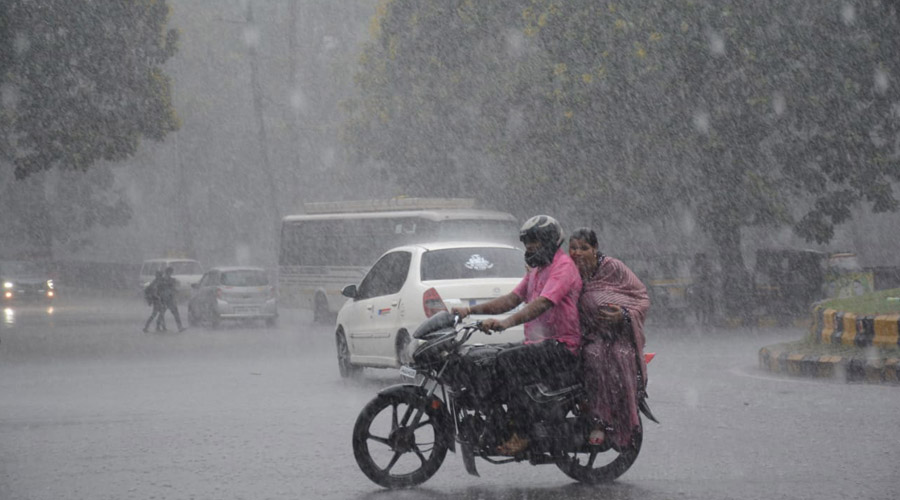Weather-roiling El Nino is threatening to play the monsoon spoiler. Both private forecaster Skynet and the Indian Meteorological Department agree the monsoon won’t be especially abundant this year. But the potential June arrival of El Nino could upend the not-so-great rainy season forecast into a really bad one.
“The scare of El Nino this year is real and the second half of the (monsoon) season is likely to be impacted strongly,” Skynet's weather team said on the forecaster’s website.
Right now, Skynet expects the rains to be below normal at 94 per cent of the long period average – or LPA – while IMD, the government’s agency, IMD, says the monsoon will be normal at 96 per cent of the LPA. As both forecasts have built-in error margins of plus or minus 5 per cent, they’re broadly in line with each other.
“The Skynet forecast is on the higher end of 'below normal' and IMD forecast is on the lowest end of 'normal',” Skynet said. In fact, it added that there “can hardly be any better consensus on their monsoon forecast between any two independent weather agencies.”
El Nino: 70% probability
On Friday, though, there was an important development. While not changing its monsoon rain forecast, the IMD said there was a 70 per cent probability of El Nino – which means “little boy” in Spanish – arriving in the June, July, August monsoon period. And if El Nino doesn’t turn up in June, the IMD said there’s an 80 per cent chance that it will turn up in July. That’s up from the 50 per cent it said earlier in the week was the likelihood of El Nino coming in June.
El Nino is a wild card that could dramatically change the outlook for the rainy season. El Nino is part of a climate phenomenon called the El Nino Southern Oscillation system and its opposite number, La Nina – which means “little girl” – both significantly affect weather patterns worldwide.
Weather forecasters globally say there is unusual unanimity among climate models calling for the arrival of El Nino in the next few months. An update just issued by the US weather agencies also says climate models show a “high chance” of a return to El Nino in June.
Rapid development
“Right now, the atmosphere and the ocean are both in sync and screaming 'El Nino rapid development,’ “ climate scientist Daniel Swain told US network CNN.
So, what could the onset of El Nino mean in precise terms for India? Skynet spells it out succinctly: Since the year 2000, there have been six years when El Nino has been a factor in the monsoon. Those years are 2002, 2004, 2009, 2014, 2015 and 2018. Five of these years saw a drought. Two of those years – in 2002 and 2009 – saw “severe” droughts. The sixth and the last year in 2018 narrowly averted drought and ended with 90.6 per cent rainfall of LPA.
El Nino occurs when the equatorial Pacific warms up and reacts with the atmosphere to disrupt weather patterns. (La Nina sees cooler-than-average surface sea temperatures and keeps global temperatures lower). For places like the US and South America, El Nino can bring welcome rain to drought-parched areas and reduce hurricane activity. But for India and other parts of Asia, along with Australia, it means hotter, drier conditions.
Mini global warming event
In fact, an El Nino year creates a mini global-warming event since warm water spreading across the Pacific releases heat into the atmosphere. There are already predictions that an El Nino this year could hike the planet’s average surface temperature by more than 1.5° C from pre-industrial levels. The increase would be temporary but it would breach the cornerstone of the Paris Agreement. Already, the Indian weather office is warning of heatwave conditions in the second half of April and the month of May.
El Nino and La Nina typically last for nine to 12 months, but they can keep going for four years. Usually, El Nino starts to form between June and August and reaches its peak between December and April. Normally, El Nino occurs at intervals of two to seven years. But scientists believe climate change is causing El Nino to occur more frequently and more intensely than before.
Since 2019, India has enjoyed normal and above-normal monsoons. The El Nino forecast for this year comes after an unusual three-year run of La Nina. The three-year length is a rare phenomenon called a “triple-dip” that hasn’t been seen since 1950.
Transition time
“The southwest monsoon in India saw above-normal/normal rainfall in the last four years because of the triple-dip-La Nina,” said Jatin Singh, managing director of Skynet Weather. “Now, La Nina has ended,” he said.
In India’s case, transitioning from a La Nina winter (which we’re doing now) to a summer El Nino state can result in a monsoon deficit of up to 15 per cent although there would be pockets of heavy or very heavy rainfall, weather experts say.
Over half the major droughts in India in the last 140 years have coincided with El Nino. El Nino conditions usually lead also to uneven rainfall distribution. One of El Nino’s other unpleasant effects is a higher incidence of mosquito-related diseases such as malaria and dengue.
Skynet said there can never be any monsoon “bull’s-eye” forecast. But there was one prediction Skynet was confident in making: “The monsoon 2023 is likely to proceed under the shadow of El Nino and the season is unlikely to be without suspense and thrills.”











